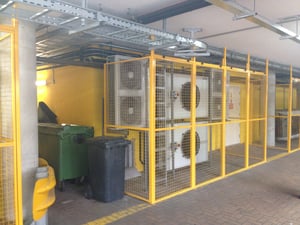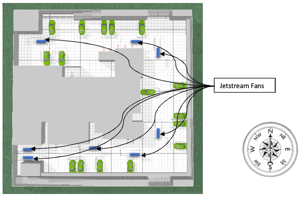 It is commonly known that underground car parks need to be ventilated to remove the build-up of exhaust fumes and in some instances for smoke ventilation. However, another common problem that is less discussed is the need for ventilation in underground car parks and basements where overheating occurs due to air conditioning condenser units being installed within them. This is the problem that we helped our clients at “Discovery” solve.
It is commonly known that underground car parks need to be ventilated to remove the build-up of exhaust fumes and in some instances for smoke ventilation. However, another common problem that is less discussed is the need for ventilation in underground car parks and basements where overheating occurs due to air conditioning condenser units being installed within them. This is the problem that we helped our clients at “Discovery” solve.
To understand why this issue occurs, let’s start with a basic explanation of how a traditional AC system operates and how it should be installed to get the maximum performance out of it. Typically, traditional air conditioning systems have an internal and external unit that work together to exchange warmth and coolth to achieve the desired internal temperature. In the summertime, the air conditioning system provides cool air by actually removing heat from the indoor air, transferring it to outside through a pipe circuit filled with refrigerant.
 As the external unit is rejecting heat directly into the outside atmosphere, they are ordinarily installed somewhere where there is a lot of free-moving air around, such as a rooftop or a less visible outside wall. However, this is not always possible, depending on building design or space restrictions. In instances like this, we find that a common solution is to put the ‘external’ AC unit into a basement or underground car park to ensure it doesn’t interfere with the building aesthetics, which is what had happened at Discovery. Unfortunately, the fact that these areas are generally very poorly ventilated creates two big, unintentional problems:
As the external unit is rejecting heat directly into the outside atmosphere, they are ordinarily installed somewhere where there is a lot of free-moving air around, such as a rooftop or a less visible outside wall. However, this is not always possible, depending on building design or space restrictions. In instances like this, we find that a common solution is to put the ‘external’ AC unit into a basement or underground car park to ensure it doesn’t interfere with the building aesthetics, which is what had happened at Discovery. Unfortunately, the fact that these areas are generally very poorly ventilated creates two big, unintentional problems:
- The heat that the AC unit is trying to expel gets trapped underground and creates uncomfortably warm conditions.
- When the heat is trapped in this way, the AC system can’t perform as it is supposed to because it is not able to keep removing the warm air from the inside of the building effectively. This then has a knock-on effect on the performance and efficiency of the AC system, meaning the interior temperature isn’t as cool as it should be, and the running costs can be significantly higher.
To solve both the overheating and AC performance issues, the Colt solution was to provide a mechanical ventilation system that works on the principles of dilution ventilation. This involved installing a ventilation system in the underground area that removes the hot air from the area and brings in some cooler, fresh air so that the underground space can remain at a comfortable temperature. The addition of the fresh, moving air into the space where the exterior AC unit is installed also helps to improve the performance of the AC system as a whole, which means better internal conditions for everyone.

As underground car parks are usually shallow, landlocked spaces, a typical solution would be to have a mechanical extract plant in one corner of the car park where the warm air is extracted using fans and released into the outside world. Replacement air will typically come in through the entrance and exit ramps of the car park. To avoid the fresh outside air moving directly from the entrance to the extract plant, strategically placed fans throughout the car park will blow air into corners or spaces that aren’t ordinarily well ventilated. Originally designed for smoke and fume control, our Jetstream Car Park Impulse Jet Fans and Cyclone Centrifugal Induction Fans are used to redirect and move the fresh air around.
Both Jetstream and Cyclone use tunnel ventilation technology to eliminate the need for costly and bulky ductwork. Compared to ductwork systems, this may save car-parking spaces, reduce running costs and noise, and make the car park a lighter, less cluttered environment. To find out more about Jetstream, click here. For more information on Cyclone, click here.
If you have an underground car park or basement area that is overheating or causing your air conditioning system’s performance to drop, talk to one of our Climate Control experts today for the right solution.
If your building is too hot or too cold, if your process gives off fume or moisture, if your product requires specific conditions during its manufacture or storage, or if noise is a concern, then we may be able to help you.
We can survey your building using a range of techniques and equipment to identify your problem. Once established, we can then recommend a solution based on proven design work.
Request a no obligation consultation with one of our technical experts
 Laurence Cockman is a Technical Manager for Colt UK Climate Control Division and specialises in the design and product application of energy efficient HVAC systems.
Laurence Cockman is a Technical Manager for Colt UK Climate Control Division and specialises in the design and product application of energy efficient HVAC systems.


